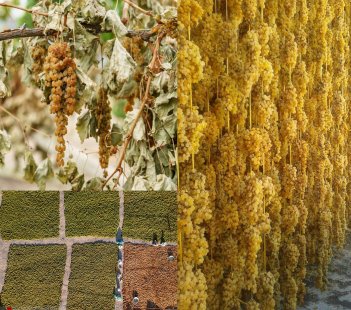
Another plan is partially to sever the stalk before the grapes are quite ripe, thus stopping the flow of the sap, and in that condition to leave them on the vines till they are sufficiently dry.
How to prepare raisins
The more usual process, however, is to cut off the fully ripe clusters and expose them, spread out, for several days to the rays of the sun, taking care that they are not injured by rain.
In unfavorable weather, they may be dried in a heated chamber, but are then inferior in quality.
In some parts of Spain and France, it is common to dip the gathered clusters in boiling water, or in strong potash lye, a practice that softens the skin favors drying and gives the raisins a clear glossy appearance.
Again, in Minor Asia, the fruit is dipped into hot water on the surface of which swims a layer of olive oil, which communicates a bright luster and softness to the skin.
Some superior varieties are treated with very great care, retained on their stalks, and sent into the market as clusters for table use; but the greater part is separated from the stalks in the process of drying and the stalks winnowed out of the fruit.
Raisins come from numerous Mediterranean localities, and present at least three raisin distinct varieties:
- Ordinary or large raisins
- Sultana seedless raisins
- Currants or Corinthian raisins.






User comments